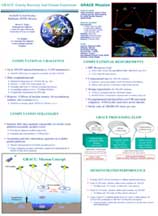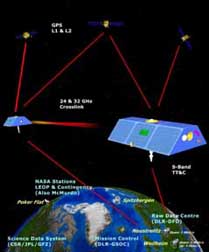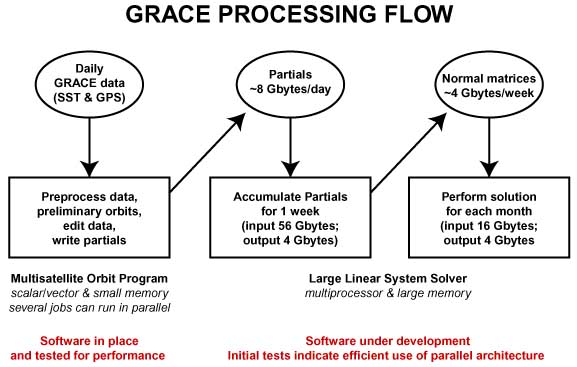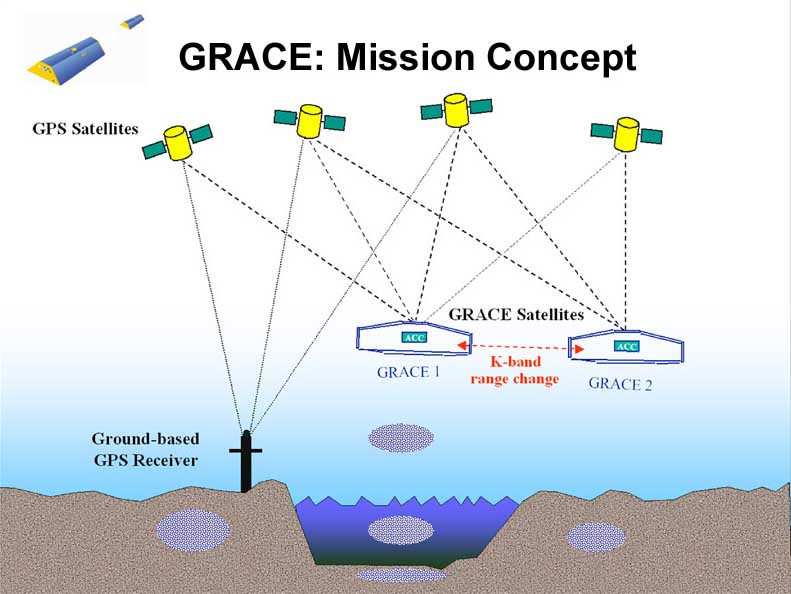GRACE:
Gravity Recovery And Climate Experiment
An Earth System Science Pathfinder (ESSP) Mission
Byron D. Tapley
(Principal Investigator)
Center for Space Research
The University of Texas at Austin
Chris Reigber
(Co-Principal Investigator)
GeoForschungsZentrum
Potsdam
|
 |
GRACE Mission
 Science Goals
Science Goals
High resolution, mean & time variable gravity field mapping for Earth System Science applications
Mission Systems
Instruments
- HAIRS (JPL/SSL/APL)
- SuperSTAR (ONERA)
- Star Cameras (DTU)
- GPS Receiver (JPL)
Satellite (JPL/DSS)
Launcher (DLR/Eurokot)
Operations (DLR/GSOC)
Science (CSR/JPL/GFZ)
Orbit
Launch: February 2002
Altitude: 485 km
Inclination: 89 deg
Eccentricity: ~0.001
Lifetime: 5 years
Non-Repeat Ground Track, Earth Pointed, 3-Axis Stable
COMPUTATIONAL CHALLENGE
Up to 180x180 spherical harmonics (~32,400 parameters) n
- 180x180 solution may be required to accurately smooth to 160x160
Daily computational task
- Numerical integration of ~194,000 dif. eq (6n)
- Process ~17,280 SST observations (m)
- Calculate and write 4.5 Gbytes of partial derivatives
- Accumulate partials (m*n*n ~18 trillion FLOPs)
- Comparable requirements for GPS data
Requires > 8 Gbytes of machine memory for accumulation, solution, and covariance (n*n)
- Solution covariance alone will be 4.2 Gbytes (n*n/2)
COMPUTATIONAL REQUIREMENTS
HPC Resources Used
- TACC T3Es, NASA T3E and ORIGIN 2000, CSR/TACC Cray SV-1
- TACC SGI/STK Data Archive
Computational rate (for 180x180 solution)
- Each day's processing requires 30-60 CPU hours (@200 Mflops)
- Must be able to process several days worth of data each day
Storage requirements (for 180x180 solution)
- ~8 Gbytes or partials each day (shprt term storage)
- 400-800 Gbytes of information equations and covariances each year
If computational load shared between CSR and remote computers, ~8 Gbytes/day must move across internet
On order of 100,000 CPU hours per year
COMPUTATION STRATEGIES
Generate daily data equations concurrently on current vector platform (essentially parallel/vector)
- Edit data & integrate satellite trajectories
- Calculate and write partials (~8 Gbytes/day)
Accumulate and solve information equations on available parallel platforms
- Already demonstrated to be highly parallel process
- Using computing resources elsewhere requires moving hunmdreds of Gbytes of data across internet


DEMONSTRATED PERFORMANCE
Working with PLAPACK developers to enhance parallel performance
Using 32 T3E nodes, calculate soultion and covariance for 110x110
- 334 Mflops/node (50% peak), 11 Gflops total, 7 min wallcloack
Using 512 T3E nodes, calculate solution and covariance for 200x200
- 183 Mflops/node (30% peak), 94 Gflops effective total speed
Using a single SV-1 MultiStreaming Processor, nearly 1 Gflop attained for 120x120
data accumulation (MSP has 4.8 Gflop theoretical peak)
- Actual performance significantly affected by overall load on machine due to memory bandwidth limitations
|





